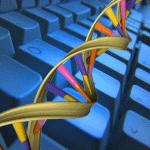Bioinformatics
|
23 june 2017 10:44:57 |
| A QM/MM Study of the Catalytic Mechanism of SAM Methyltransferase RlmN from Escherichia coli (Proteins: Structure, Function, and Bioinformatics) |
|
Tweet RlmN is a radical S-adenosylmethionine (SAM) enzyme that catalyzes the C2 methylation of adenosine 2503 (A2503) in 23S rRNA and adenosine 37 (A37) in several Escherichia coli transfer RNAs (tRNA). The catalytic reaction of RlmN is distinctly different from that of typical SAM-dependent methyltransferases that employs an SN2 mechanism, but follows a ping-pong mechanism which involves the intermediate methylation of a conserved cysteine residue. Recently, the x-ray structure of a key intermediate in the RlmN reaction has been reported, allowing us to perform combined quantum mechanics and molecular mechanics (QM/MM) calculations to delineate the reaction details of RlmN at atomic level. Starting from the Cross-Linked RlmN C118A-tRNA complex, the possible mechanisms for both the formation and the resolution of the cross-linked species (IM2) have been illuminated. On the basis of our calculations, IM2 is formed by the attack of the C355-based methylene radical on the sp2-hybridized C2 of the adenosine ring, corresponding to energy barrier of 14.4 kcal/mol, and the resolution of IM2 is confirmed to follow a radical fragmentation mechanism. The cleavage of Cī-Sī bond of mC355-A37 cross-link is in concert with the deprotonation of C2 by C118 residue, which is the rate-limiting step with an energy barrier of 17.4 kcal/mol. Moreover, the cleavage of Cī-Sī bond of IM2 can occur independently, i.e., it does not require the loss of an electron of IM2 and the formation of disulfide bond between C355 and C118 as precondition. These findings would deepen the understanding of the catalysis of RlmN. This article is protected by copyright. All rights reserved. |
| 96 viewsCategory: Biochemistry, Bioinformatics |
 Alpha/beta-Hydrolases: A unique structural motif coordinates catalytic acid residue in 40 protein fold families (Proteins: Structure, Function, and Bioinformatics) Alpha/beta-Hydrolases: A unique structural motif coordinates catalytic acid residue in 40 protein fold families (Proteins: Structure, Function, and Bioinformatics)Geometrical Principles of Homomeric ?-barrels and ?-helices: Application to Modelling Amyloid Protofilaments (Proteins: Structure, Function, and Bioinformatics) 
|
| blog comments powered by Disqus |
MyJournals.org
The latest issues of all your favorite science journals on one page
The latest issues of all your favorite science journals on one page



